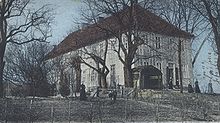Friesack Castle
| Friesack Castle | ||
|---|---|---|
|
The Friesack castle ruins at the time of the Thirty Years War , drawn in 1894 |
||
| Creation time : | before 1150 | |
| Castle type : | Niederungsburg, swamp castle | |
| Place: | Friesack | |
| Geographical location | 52 ° 44 ′ 33 " N , 12 ° 34 ′ 42" E | |
|
|
||
The Burg Friesack was a medieval lowland castle , more precisely, a Marsh Castle , in the town of Friesack in Havelland in Brandenburg . The castle stables of the facility are listed both as an architectural monument and as a ground monument (monument number 50695) in the list of monuments of the state of Brandenburg .
location
Five plateaus rose from the Havelland Luch and the Rhinluch , which looked like islands, especially in spring. These were Glin , Ländchen Bellin , Nusswinkel, Ländchen Rhinow and Ländchen Friesack . At one and a half square miles, the little country Friesack was the second largest island after the Glin.
history
The castle is said to have existed as a Slavic rampart when Albrecht the Bear took possession of the Mark Brandenburg in 1150 . Albrecht had Frisian and Dutch dike and water builders build a dam through the swamps of the Rhin and Havelland Luche. The small country Friesack formed the beginning of the road, which was connected with the small country Bellin and later with the country Ruppin . The castle at the beginning of the road was expanded into a mighty water castle made of stone, whereby the then wild water of the Rhins was forced through sewers around three sides of the castle. It was one of the eight national fortresses. The first documentary mention as "Vrisac" dates back to December 28, 1216, when the Brandenburg Bishop Siegfried II confirmed his archdeaconate rights to the Brandenburg Cathedral Chapter when he took office .
One possible variant of the origin of the name Friesack is based on the assumption that, due to the Frisian builders, the Low German name for water (ack) was combined with the name "Friesen". But there are other plausible explanations as well.
The castle was given to the nobles von Friesack as a fief. This family "von Friesack" died out towards the end of the 13th century, so that the property fell back to the Ascanian rule. But the Ascanian house also died out in 1320. In a document from 1318 the castle complex was called castro .
The now reigning Margrave Ludwig the Elder owed the Bredows , a family living in the Nauen area since 1250 , around 300,000 euros in today's monetary value. He paid off this debt in 1335 by enfeoffing the Bredows with the castle, town and country Friesack as well as with the Zootzen (an extensive, higher fertile parcel north of Friesack). In 1399, Margrave Jobst of Moravia conquered the castle because the Bredows had sided with the Archbishop of Magdeburg, an opponent of the Elector. In 1409 Dietrich von Quitzow acquired the castle, which made the place more important. Not a laudable one, however, because the brothers Dietrich von Quitzow auf Friesack and Johann (Hans) von Quitzow auf der Plaue, married to a Bredow from the Cremmen line, were in perpetual feuds against the neighboring towns and villages. The raids went as far as Berlin.
In order to put an end to robber baronship in the march, the burgrave Friedrich VI. appointed by Hohenzollern from Nuremberg as governor. In February 1414 he conquered Friesack Castle. A large cannon (blunderbuss) was used, which shot 150 kilogram stones. Because of her great weight and the fact that she could only fire three shots in a day, she was called " Lazy Grete ". As a reward for the overthrow of the robber barons in the area, Friedrich was enfeoffed with the Mark Brandenburg and thus, as Friedrich I, the first Hohenzoller of this mark. Ernst von Wildenbruch processed this act in 1888 into the play " The Quitzows ".
After the Quitzow period, the castle, the town and the little country returned to the possession of the von Bredow family , who finally thought it better to stay with the margrave. Towards the end of the 15th century, twelve independent family members of the Bredows lived there. The many inheritance divisions resulted in increasingly complicated relationships. The Bredows lived in the castle grounds until the middle of the 19th century. To 1808 Friesack here was the manorial subject. The castle has burned down and rebuilt several times over the years. Instead of the castle, the Bredows then built mansions , called Friesack I and Friesack II, which were either demolished or destroyed by fire in GDR times.
Due to the widespread use of the Bredows, the anecdote mentioned in the introduction to the article Friesack was created, which was further developed as required.
Individual evidence
- ↑ List of monuments of the State of Brandenburg: District Havelland (PDF) Brandenburg State Office for Monument Preservation and State Archaeological Museum
- ^ Slavic castles in Brandenburg A - M (119) . Friesack. slawenburgen.npage.de. Accessed June 17, 2018.


